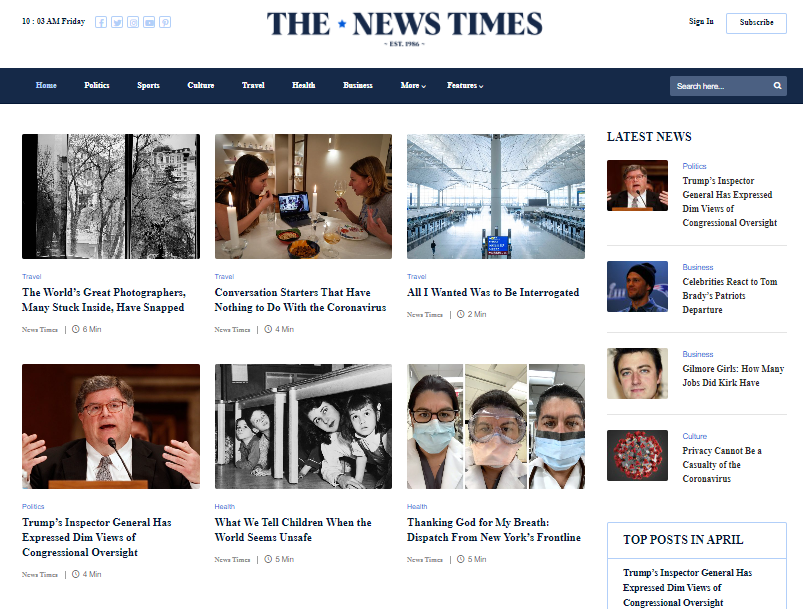How stnews.live Helps Combat Misinformation
The Influence of Social Media Site on the Way We Eat News Online
Social network has actually fundamentally transformed news usage. It supplies instant accessibility to details, often eclipsing conventional media outlets. This quick dissemination comes with challenges. Customers face the risk of running into misinformation and becoming entraped in resemble chambers. The algorithms driving customized web content can cover diverse viewpoints. As these characteristics progress, recognizing their effects ends up being essential for informed engagement in public discussion. What methods might assist navigate this facility landscape?
The Development of News Consumption in the Digital Age
As innovation advanced, the means individuals consumed news changed substantially in the digital age (stnews.live). Standard papers and transmitted media started to decrease as the net became a main resource of details. On-line systems provided instant accessibility to newspaper article, video clips, and podcasts, enabling customers to remain educated at any moment. The benefit of smart phones further increased this shift, making it possible for individuals to receive updates on the go
Additionally, the rise of news collectors and sites helped with the consumption of diverse point of views, equipping individuals to tailor their news intake based on individual passions. This evolution also triggered wire service to adjust their approaches, concentrating on electronic material and interesting readers through multimedia layouts. Therefore, the typical barriers of time and space in news delivery decreased, causing a more instant and individualized news experience for audiences worldwide.
The Role of Social Media Site Operatings Systems in News Distribution
Social network systems have transformed news circulation by supplying instant accessibility to information. Their algorithm-driven material curation typically prioritizes involvement over accuracy, bring about substantial trustworthiness difficulties (stnews.live). As customers navigate this landscape, the effects for news consumption and public discussion come to be progressively complicated
Instant News Accessibility
Although traditional news outlets have long been the primary resource of info, the increase of social media sites systems has dramatically transformed just how news is accessed and taken in. Instantaneous news access has actually come to be a hallmark of the digital age, allowing individuals to get updates in actual time. Platforms such as Twitter, Facebook, and Instagram permit news to spread quickly, typically going beyond conventional media in rate and reach. Users can share tales, talk about events, and involve with reporters, developing a vibrant communication between the target market and news web content. This immediacy fosters a culture of necessity, triggering individuals to inquire swiftly. The assumption for timely news has improved journalistic methods, compelling news companies to adjust their methods to fulfill the demands of a busy digital atmosphere.
Algorithm-Driven Web content
While individuals proactively involve with material on social media sites, the algorithms that govern these systems play a crucial duty in determining which newspaper article gain visibility. These algorithms assess individual behavior, choices, and involvement metrics to curate tailored news feeds. Therefore, specific stories may be intensified while others continue to be odd, typically focusing on mind-blowing or trending subjects over substantive coverage. This selective exposure forms customers' perceptions of current occasions and influences public discussion. Additionally, the reliance on algorithm-driven web content can develop resemble chambers, where individuals are mostly revealed to point of views that line up with their very own beliefs. The characteristics of news distribution on social media platforms considerably impact how individuals eat and translate info in the electronic age.
Trustworthiness Challenges
As customers significantly transform to social networks for news, the reliability of details run into on these platforms ends up being a pressing issue. The decentralized nature of social media sites permits any person to publish content, frequently obscuring the lines in between trustworthy journalism and misinformation. Algorithms prioritize interaction over accuracy, leading to the extensive dissemination of marvelous or misleading stories. This environment poses significant challenges for users attempting to discern credible resources. Social media site systems, while endeavoring to combat false information through fact-checking and material small amounts, face objection for inconsistencies and biases in their methods. Eventually, the responsibility lies with individuals to seriously review the news they take in, as the fast spread of details commonly outmatches confirmation initiatives by systems.
The Increase of Citizen Journalism and User-Generated Material
The surge of resident journalism has empowered daily people to share news and viewpoints, frequently offering insights that standard media might neglect. Nonetheless, this change also provides substantial obstacles, particularly the spread of misinformation that can occur from unproven web content. As user-generated content becomes more prevalent, the balance in between genuine voices and accuracy in coverage remains a critical issue.
Encouraging Day-to-day Voices

Difficulties of False information
While the rise of citizen journalism has actually opened avenues for diverse voices in the media landscape, it has actually also presented considerable obstacles connected to false information. The ease of sharing info with social media platforms permits individuals to distribute read the article news quickly, however this quick spread typically comes with the cost of accuracy. User-generated content frequently lacks the strenuous fact-checking and content oversight that conventional journalism supplies. Sensationalized or incorrect stories can gain grip, misdirecting audiences and shaping public perception. The blending of viewpoint and truth within social media complicates the difference in between reputable information and misinformation. Therefore, consumers must browse an increasingly complex media setting, needing vital thinking abilities to determine reliable news resources in the middle of the sound

Misinformation and Its Implications for Public Discourse
As social media platforms significantly dominate the landscape of details dissemination, the expansion of misinformation postures substantial difficulties for public discussion. False information, frequently made to misinform or provoke psychological actions, can misshape perceptions of reality and weaken count on qualified resources. This phenomenon brings about polarized perspectives, as people gravitate in the direction of echo chambers that enhance their beliefs, even more lodging divisions within society.
The ramifications for public discussion are extensive. When people count on incorrect information, purposeful dialogue decreases, and the autonomous process suffers. Misinformation can prompt anxiety and confusion, affecting public health and wellness, safety and security, and political stability. Therefore, cultivating media literacy becomes crucial, empowering individuals to critically assess details and discern fact from fiction. Attending to the challenges posed by misinformation is important for protecting the stability of public discourse and ensuring a well-informed populace with the ability of participating in constructive conversations.
The Influence of Algorithms on News Visibility
Given the central role of formulas in figuring out content exposure, their influence on news usage is profound. These algorithms, made use of by social media systems, prioritize certain kinds of content based upon customer engagement and preferences. As a result, news short articles that line up with prominent patterns or audience interests are a lot more most likely to be shown prominently, while less marvelous stories might be overlooked. This develops an environment where customers are revealed largely to info that strengthens their viewpoints, possibly causing echo chambers.
The continuous evolution of formulas means that news companies have to adapt their strategies to align with these changing specifications, commonly prioritizing clickbait or emotionally billed headlines. Subsequently, the integrity of news coverage can be compromised, as important stories may not obtain the visibility they are worthy of. The algorithmic shaping of news exposure consequently plays a necessary role in affecting public understanding and understanding of existing events.
The Shift Toward Aesthetic Storytelling in News Media
Increasingly, news media is accepting aesthetic narration as an effective tool to engage audiences. This strategy leverages pictures, video clips, infographics, and interactive elements to convey info better than standard text-based styles. As focus spans shorten, visuals provide a fast, impactful method to connect intricate tales and get hold of visitors' interest.
Platforms like Instagram and TikTok have more increased this fad, engaging wire service to adjust their web content approaches to fit these visually-driven settings. By including engaging visuals, news this link electrical outlets can boost psychological links and foster better understanding of topical concerns.
Visual narration enables for even more varied narratives, showcasing multiple point of views through vibrant presentations. As audiences progressively take in news via mobile devices, the change towards visuals not only satisfies individual preferences but also helps to break down obstacles to information gain access to. Eventually, this evolution shows a more comprehensive improvement in exactly how news is produced and eaten in the electronic age.
Future Fads: Navigating the Changing Landscape of News Intake
While the electronic landscape remains to evolve, news intake is poised for significant transformation driven by arising innovations and changing target market behaviors. As expert system and artificial intelligence breakthrough, personalized news feeds will come to be extra widespread, allowing customers to get content tailored to their passions. This customization could lead to better engagement but additionally increase worries regarding echo chambers and misinformation.
In addition, the rise of voice-activated devices and wise speakers will certainly influence exactly how news is supplied, shifting the emphasis from aesthetic to acoustic layouts. This trend may encourage wire service to embrace even more succinct and interesting audio web content.

Regularly Asked Inquiries
Exactly How Do Social Network Interactions Affect News Reliability?
Social network interactions can significantly influence perceptions of news reputation. Involvement metrics, such as sort and shares, typically shape audience trust fund, with popular posts gaining regarded authenticity, regardless of the precision or dependability of the info presented.
What Duty Do Influencers Play in Shaping News Narratives?
Influencers considerably shape news stories by leveraging their systems to enhance particular tales, often customizing material to their target market. This can cause prejudiced viewpoints, affecting public perception and focusing on sensationalism over factual coverage.
How Can Users Identify Reliable News Resources on Social Network?
Individuals can identify dependable news sources on social networks by examining the source's reliability, confirming facts with several electrical outlets, assessing the professionalism and reliability of the web content, and recognizing prospective biases in reporting to ensure accurate info.
What Influence Does Social Media Carry Traditional Journalism Jobs?
Social network substantially impacts typical journalism jobs by changing earnings models, decreasing need for print media, and cultivating competitors from resident reporters. Numerous experts encounter job instability and have to adjust to rapidly altering media landscapes.
Just How Do Different Demographics Consume News on Social Media Site?
Various demographics show varied preferences for news usage on social media. Younger target markets favor systems like TikTok and Instagram for fast updates, while older people have a tendency to like Facebook and Twitter for extra in-depth conversations and posts.